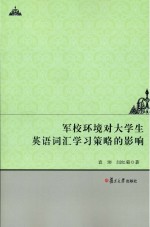图书介绍
军校环境对大学生英语词汇学习策略的影响【2025|PDF|Epub|mobi|kindle电子书版本百度云盘下载】

- 袁沛,闫红菊著 著
- 出版社: 上海:复旦大学出版社
- ISBN:9787309112146
- 出版时间:2015
- 标注页数:204页
- 文件大小:3MB
- 文件页数:218页
- 主题词:军事院校-大学生-英语-词汇-学习方法-研究-中国
PDF下载
下载说明
军校环境对大学生英语词汇学习策略的影响PDF格式电子书版下载
下载的文件为RAR压缩包。需要使用解压软件进行解压得到PDF格式图书。建议使用BT下载工具Free Download Manager进行下载,简称FDM(免费,没有广告,支持多平台)。本站资源全部打包为BT种子。所以需要使用专业的BT下载软件进行下载。如BitComet qBittorrent uTorrent等BT下载工具。迅雷目前由于本站不是热门资源。不推荐使用!后期资源热门了。安装了迅雷也可以迅雷进行下载!
(文件页数 要大于 标注页数,上中下等多册电子书除外)
注意:本站所有压缩包均有解压码: 点击下载压缩包解压工具
图书目录
Chapter One Introduction1
1 1 Background of the Research1
1.2 Significance of the Study2
1.2.1 Learning Context2
1.2.2 College Context3
1.2.3 Military Context4
Chapter Two Literature Review7
2.1 Foreign Language Learning Strategies7
2.1.1 Overview of Language Learning Strategies7
2.1.2 Taxonomies of Language Learning Strategies8
2.1.2.1 O'Malley and Chomot's Category9
2.1.2.2 Oxford's Taxonomy9
2.2 Vocabulary Learning Strategies12
2.2.1 Language Learning Strategies vs. Vocabulary Learning Strategies12
2.2.2 Taxonomies of Vocabulary Learning Strategies13
2.3 Prior Empirical Research on Vocabulary Learning Strategies16
2.3.1 Schmitt's Study16
2.3.2 Gu and Johnson's Study17
2.3.3 Wu Xia and Wang Qiang's Study17
2.3.4 Wang Wenyu's Study18
2.3.5 Limitations of Previous Studies19
2.4 Purpose of This Study20
Chapter Three Theoretical Frame22
3.1 Metacognitive Strategies22
3.1.1 Metacognition22
3.1.2 The Definition of M etacognitive Strategies25
3.1.3 The Classification of Metacognitive Strategies26
3.2 Cognitive Perspectives on Language Learning30
3.2.1 Hypothesis-Testing Theory30
3.2.1.1 The Definition of Hypothesis-Testing Theory30
3.2.1.2 The Process of Hypothesis-Testing30
3.2.2 Levels of Processing Framework32
3.2.3 Involvement Load Hypothesis33
3.2.4 Repetition or Rehearsal34
3.2.5 Noticing Hypothesis35
3.2.6 Functions of Note-Taking37
Chapter Four The Empirical Study39
4.1 The Pilot Study39
4.1.1 Purpose39
4.1.2 Participants39
4.1.3 Instrument40
4.1.4 Procedures41
4.2 The Main Study42
4.2.1 Research Questions42
4.2.2 Subjects42
4.2.3 Instruments43
4.2.4 Procedure44
Chapter Five Results and Discussion45
5.1 0verview of the Empirical Study45
5.2 Cadets' Vocabulary Learning Beliefs,Strategies and Learning Outcomes47
5.3 Strategies Used Between Successful Learners and Less Successful Learners59
5.4 Different Context in Strategy Use64
Chapter Six Effectiveness of Metacognitive Strategies Training71
6.1 Purpose71
6.2 Framework of the Metacognitive Strategies Training72
6.3 Participants93
6.4 Group Design94
6.4.1 Group Design94
6.4.2 Advantages of This Design94
6.5 Instruments95
6.6 Experimental Schedule96
6.7 Data Collection,Analyses and Discussion96
6.7.1 Data Collection,Analyses and Discussion of the Vocabulary Tests96
6.7.1.1 Data Collection and Analyses96
6.7.1.2 Data Discussion103
6.7.2 Data Collection,Analyses and Discussion of the Questionnaire104
6.7.2.1 Results ofPre-Treatment Questionnaire104
6.7.2.2 Results of Post-Treatment Questionnaire107
6.7.2.3 Data Discussion of the Questionnaire109
6.7.3 Correlation Analysis between Metacogni tive Strategies and VocabularyProficiency111
6.7.4 Major Findings112
Chapter Seven Effectiveness of Guessing and Bidic Strategies Training116
7.1 Purpose116
7.2 Framework of the Guessing Strategy Training117
7.3 Framework of the Strategy Training of Consulting a Bilingualized Dictionary123
7.4 Participants126
7.5 Method126
7.5.1 Passages Selected for the Experiment126
7.5.2 Target Words for Testing127
7.5.3 Task Design128
7.5.4 Procedures and Tests129
7.6 Data Collection,Analyses and Discussion130
7.6.1 Data Collection and Analyses130
7.6.2 Data Discussion135
Chapter Eight Effectiveness of Note-Taking Strategy Training142
8 1 Purpose142
8.2 Framework of the Note-Taking Strategy Training143
8.3 Experiment One148
8.3.1 Participants148
8.3.2 Group Design148
8.3.2.1 Group Design148
8.3.2.2 Advantages of This Design149
8.3.3 Target Words and Expressions149
8.3.4 Experimental Schedule149
8.3.5 Test150
8.3.6 Data Collection and Analyses152
8.3.6.1 Data Collection and Analyses of Test One152
8.3.6.2 Data Collection and Analyses of Test Two153
8.4 Experiment Two155
8.4.1 Participants155
8.4.2 Group Design156
8.4.2.1 Group Design156
8.4.2.2 Advantages of This Design156
8.4.3 Target Words and Expressions156
8.4.4 Experimental Schedule156
8.4.5 Test157
8.4.6 Data Collection,Analyses and Discussion159
8.4.6.1 Data Collection and Analyses of Test One159
8.4.6.2 Data Collection and Analyses of Test Two160
8.5 Major Findings163
Chapter Nine Conclusions and Suggestions167
9.1 Conclusions167
9.2 Implications170
9.3 Limitations172
9.4 Recommendations172
References174
Appendix A185
Appendix B187
Appendix C189
Appendix D191
Appendix E192
Appendix F196
Appendix G197
Appendix H203
热门推荐
- 1599383.html
- 296910.html
- 2049779.html
- 1784812.html
- 3401106.html
- 2610175.html
- 819481.html
- 700000.html
- 2746388.html
- 3474809.html
- http://www.ickdjs.cc/book_335008.html
- http://www.ickdjs.cc/book_1047726.html
- http://www.ickdjs.cc/book_3842246.html
- http://www.ickdjs.cc/book_65334.html
- http://www.ickdjs.cc/book_3635109.html
- http://www.ickdjs.cc/book_1389894.html
- http://www.ickdjs.cc/book_3583149.html
- http://www.ickdjs.cc/book_1889952.html
- http://www.ickdjs.cc/book_2923208.html
- http://www.ickdjs.cc/book_2754798.html